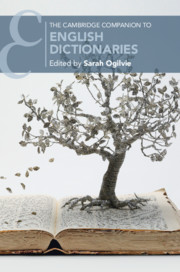Book contents
- The Cambridge Companion to English Dictionaries
- The Cambridge Companion to English Dictionaries
- Copyright page
- Dedication
- Contents
- Illustrations
- Tables
- Notes on Contributors
- Acknowledgements
- Chronology
- Chapter 1 Introduction
- Part I Issues in English Lexicography
- Part II English Dictionaries Throughout the Centuries
- Chapter 8 A Dictionary Ecosystem: Four Centuries of English Lexicography
- Seventeenth-Century English Dictionaries: Hard Words
- Eighteenth-Century English Dictionaries: Prescriptivism and Completeness
- Nineteenth-Century English Dictionaries: Descriptivism
- Twentieth and Twenty-First-Century Dictionaries
- Chapter 15 The English Period Dictionaries
- Chapter 16 English-as-a-Foreign-Language Lexicography
- Chapter 17 Electronic Dictionaries
- Chapter 18 English Dictionaries and Corpus Linguistics
- Chapter 19 Natural Language Processing in Lexicography
- Part III Dictionaries of English and Related Varieties
- Guide to Further Reading
- Index
- Cambridge Companions to Literature
Chapter 17 - Electronic Dictionaries
from Twentieth and Twenty-First-Century Dictionaries
Published online by Cambridge University Press: 18 September 2020
- The Cambridge Companion to English Dictionaries
- The Cambridge Companion to English Dictionaries
- Copyright page
- Dedication
- Contents
- Illustrations
- Tables
- Notes on Contributors
- Acknowledgements
- Chronology
- Chapter 1 Introduction
- Part I Issues in English Lexicography
- Part II English Dictionaries Throughout the Centuries
- Chapter 8 A Dictionary Ecosystem: Four Centuries of English Lexicography
- Seventeenth-Century English Dictionaries: Hard Words
- Eighteenth-Century English Dictionaries: Prescriptivism and Completeness
- Nineteenth-Century English Dictionaries: Descriptivism
- Twentieth and Twenty-First-Century Dictionaries
- Chapter 15 The English Period Dictionaries
- Chapter 16 English-as-a-Foreign-Language Lexicography
- Chapter 17 Electronic Dictionaries
- Chapter 18 English Dictionaries and Corpus Linguistics
- Chapter 19 Natural Language Processing in Lexicography
- Part III Dictionaries of English and Related Varieties
- Guide to Further Reading
- Index
- Cambridge Companions to Literature
Summary
Digital technology has had a profound and generally beneficial effect on dictionaries and other language-reference tools. Electronic dictionaries continue to evolve and it seems likely that for people born in the current century and beyond, ‘dictionary’ may cease to have its primary denotation as a thick book filled with a list of alphabetised words and their definitions. The idea of the dictionary developed over centuries to its place of privilege in the mid-twentieth century: an authoritative book that could be found in nearly every home. In the decades since then, the idea of the dictionary has rapidly evolved to become, especially for today’s digital natives, an amorphous collection of data that lives in the cloud and that should be quickly retrievable to anyone who desires to find the definition of a word they don’t know, using whatever device they have at hand. In their efforts to become the newest, best, and most dazzling, makers of electronic dictionaries today must not lose sight of the fact that the core need of their user is a simple one than can be met with a simple solution, provided to them with what is now relatively simple technology.
Keywords
- Type
- Chapter
- Information
- The Cambridge Companion to English Dictionaries , pp. 207 - 218Publisher: Cambridge University PressPrint publication year: 2020
- 2
- Cited by



